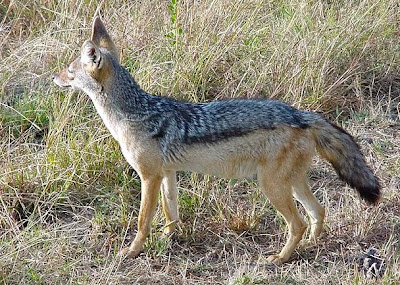 A lonely male elephant.
A lonely male elephant. The male elephant, like many other animals of his sex, are destined to being solitary roamers in their old age. Having outlived his usefulness as a breeder and protector, he lives out his life alone.
Elephants that live out their years free from predators (mainly humans) usually die of starvation. Their teeth eventually wear down to the point where they can no longer chew their food properly.
 A young leopard practicing his/her climbing. After capturing prey, leopards usually drag them up trees where they are relatively free to consume their rewards free from other animals looking for an easy meal.
A young leopard practicing his/her climbing. After capturing prey, leopards usually drag them up trees where they are relatively free to consume their rewards free from other animals looking for an easy meal.
 Reticulated Giraffe, the tallest animal on the planet. It can reach a height of 19 feet and weigh up to 2600 pounds. Even though the giraffe's neck can be as long as eight feet, it still only has seven bones, the same number of bones in the human neck.
Reticulated Giraffe, the tallest animal on the planet. It can reach a height of 19 feet and weigh up to 2600 pounds. Even though the giraffe's neck can be as long as eight feet, it still only has seven bones, the same number of bones in the human neck. Hippos are the third largest land mammals, after the Elephant and Rhino, and kill more humans than any other of the wild animals in Africa. Although some believe it's a toss-up between the Rhino and Hippo for second largest.
Hippos are the third largest land mammals, after the Elephant and Rhino, and kill more humans than any other of the wild animals in Africa. Although some believe it's a toss-up between the Rhino and Hippo for second largest.The word Hippopotamus means "water horse" and if you've ever "smelled" them at the zoo, that's precisely how they smell in the wild. They love to wallow in groups of 15 or more in muddy pools during the day and the smell certainly gets ripe after a while.
 The African Lion, although easily spotted in the game parks and reserves of Africa are an endangered species. Some estimates put the current wild population at less than 20,000.
The African Lion, although easily spotted in the game parks and reserves of Africa are an endangered species. Some estimates put the current wild population at less than 20,000.
 Above are Burchell's Zebra or common plains zebras of Africa. They are more closely related to the horse than the Grevy's Zebras, (pictured below) who are more closely related to the wild ass.
Above are Burchell's Zebra or common plains zebras of Africa. They are more closely related to the horse than the Grevy's Zebras, (pictured below) who are more closely related to the wild ass. The endangered Grevy's Zebras remain only in the northern sections of Kenya and south eastern Ethiopia today. They are larger and longer legs than the Burchell's Zebra, a stripe-free belly and round ears.
The endangered Grevy's Zebras remain only in the northern sections of Kenya and south eastern Ethiopia today. They are larger and longer legs than the Burchell's Zebra, a stripe-free belly and round ears.A third species of Zebra, Equus Zebras (also know as the mountain Zebra), resides in the southern and southwestern portions of Africa.
Zebras usually precede the Wildebeests during the great migration in the Serengeti and Masai Mara. They would trim the tall grasses and the Wildebeests would follow, digging into the short grasses.
.jpg)











1 comment:
Fantastic photos from the safari! I am enjoying reading your travel blog, you have been to some very interesting places and, as I said, the pics are great!
Wishing you many more amazing travel opportunities,
Minna
Post a Comment